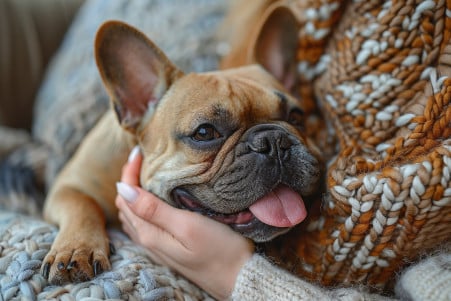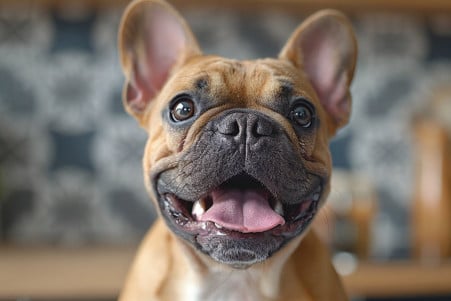Why Do Dogs Lick Themselves? Decoding Canine Grooming and Health
14 February 2024 • Updated 12 February 2024

Is your dog merely grooming itself, or could persistent licking be a sign of something more serious? While dogs lick themselves to groom and stay clean, excessive licking can also be a symptom of allergies, pain, boredom, stress, and even medical issues. Although licking is a normal behavior, if it becomes excessive, it’s important to have a vet check your dog to rule out any underlying problems.
In this deep dive into the topic, we’ll look at a wide variety of studies from veterinary science, animal psychology, and evolutionary biology to understand the many reasons for—and impacts of—self-licking in dogs. We’ll also consider the role of environmental and sensory factors in this behavior. By learning about the many aspects of this behavior, you’ll gain a better understanding of how to care for and relate to your furry friend.
Why do dogs lick themselves?
Understanding the Medical Causes of Excessive Licking in Dogs
Excessive licking in dogs may be a sign of an underlying medical condition. According to PetMD, excessive licking can lead to hair loss, skin lesions, or infections, which may be a sign of an underlying issue like allergies or other infections. In-depth investigations, including skin scrapes and tape preps, can help veterinarians pinpoint issues like yeast or bacterial infections and recommend treatment options, which may include antibiotics or antiparasitics.
Bond Vet explains that licking can also be a sign of discomfort due to issues like arthritis or dental disease, which will require a multi-faceted approach to pain management and oral care. For example, excessive grooming in specific areas, like the joints, could be a sign of joint pain that can be managed with a combination of medication, weight management, supplements, and alternative therapies.
If these signs are ignored, it can lead to issues like skin damage and chronic wounds, which are also known as lick granulomas. According to VCA Animal Hospitals, it’s important to seek veterinary care when a dog’s licking becomes excessive, as medical treatment can help improve the dog’s quality of life.
It’s important to get an accurate diagnosis and treatment plan to address the medical causes of licking so that our pets can be as comfortable and happy as possible.
The Psychology of Licking
Licking is a common way that dogs show stress, anxiety, and other behavioral issues. Oakbrook Animal Hospital explains that changes in a dog’s environment, like a new person moving in or construction, can stress dogs out and lead to compulsive grooming. Licking can also be a way that dogs cope with anxiety or Obsessive-Compulsive Disorder (OCD), a condition that is often brought on by stress, separation, or boredom.
The treatments for psychological causes of licking can include behavioral treatments and medications. A vet will be able to help determine the cause of the licking, whether it’s psychological or something else, and can even prescribe anti-anxiety medications or recommend dog trainers for behavioral issues.
It’s important for dog owners to be able to recognize their dog’s emotional state so that they can effectively deal with and minimize excessive licking. By recognizing the signs and symptoms, dog owners can help their pets relieve stress and improve their quality of life.
Understanding the psychology of dogs also helps to shed light on the relationship between a dog’s mental state and behaviors, which in turn can help us better understand their physical responses.
Why Do Dogs Lick People? Stress Relief and Emotional Responses
While licking may seem like a learned or habitual behavior, it’s actually deeply rooted in a dog’s physiology. When dogs lick, their bodies release endorphins, which are hormones that act as natural painkillers and create a sense of well-being. This physiological reaction helps dogs relieve stress and anxiety or discomfort, much like humans biting their nails or tapping their feet in stressful situations.
A study in ScienceDirect by Dr. Daniel S. Mills and colleagues found that dogs’ mouth-licking behavior is a reaction to emotional stimuli. They discovered that dogs licked more often when they were shown negative human facial expressions than when they were shown positive ones.
This indicates that dogs may have a functional understanding of human emotions and use licking as a way to signal their own stress or to relieve their own stress when they perceive others’ emotions.
For dog owners and others who work with dogs, knowing about these physiological processes can help you provide more empathetic care and understand a dog’s licking in a larger context. Instead of just a random behavior or a funny habit, it can be seen as a sign of the dog’s internal state and how they’re reacting to their surroundings or their need for comfort.
From Wolf Packs to Pet Dogs: How Licking Has Evolved
Licking is an ancient behavior that originated in wolf packs and has been passed down to today’s pet dogs. In the wild, wolf pups lick the mouths of adult wolves to stimulate regurgitation, an important part of the wolves’ feeding process. As noted in The Domestic Dog: Its Evolution, Behaviour, and Interactions with People, this behavior has been repurposed in domestic dogs to help them greet and ask for care from their human owners.
This evolutionary history has led to a number of other uses for licking beyond just asking for food. Licking has also become an important part of a dog’s hygiene, helping them get rid of parasites. This is backed up by studies of grooming in animals, including papers in PubMed that look at the development and expression of grooming in adult animals. In addition, dogs use the evaporation of saliva to help them cool down.
Research by David A. Eads and his team on black-tailed prairie dogs has shown that grooming is important for ectoparasite defense. While the licking behaviors of dogs may not be exactly the same as those of prairie dogs, they show that grooming is an important evolutionary response to parasitic threats.
Knowing this evolutionary history can help explain why different dog breeds have different licking tendencies, which are the result of their evolution to different environments and roles. This can also help us better appreciate a behavior that we now see in our pets and help us make sure we’re taking care of them properly by making sure their grooming needs are met.
Taste and Smell in Licking
Taste and smell are two of the most important senses in a dog’s world, and they are also two of the most important senses in a dog’s world.
A paper in PMC explains that dogs have individual taste preferences and often choose their food based on smell before they even taste it.
This sense of taste may be a factor in licking, as the tastes that dogs pick up from their skin may influence their licking behavior.
Dogs use licking to communicate and bond with others, and licking human feet may be a way to bond with a person based on their taste and smell, which indicates familiarity and comfort.
Displacement behaviors like licking are often seen in dogs that are stressed or anxious, according to Fun Paw Care. Knowing a dog’s individual taste preferences and the smells that they find most appealing may help to control and redirect licking.
Dogs experience the world through their senses, and owners who understand this are better equipped to deal with behaviors that may otherwise be misinterpreted. The findings of these papers are a good reminder of the importance of thinking about the environments we create for our dogs and how they may impact their sensory-based behaviors.
Environmental Factors That Impact Licking
The environments that our dogs live in have a big impact on their behaviors, including licking. According to the International Veterinary Information Service, there are a number of environmental factors that can impact a dog’s self-grooming behavior. For example, environmental changes like moving furniture or bringing in a new pet can lead to an increase in licking because these changes can cause stress or anxiety in dogs.
To help with this, keeping a dog’s environment as consistent as possible or making changes slowly can be helpful. For instance, an article from Dogsee Chew explains that providing familiar items like a dog’s favorite blanket or toy can help reduce stress-related behaviors, including licking. In addition, environmental allergens in the home, such as dust or certain types of weeds, can cause skin irritation that leads to excessive licking as a way to self-soothe.
This can be helped by working to reduce stress-related licking by creating a safe, soothing environment. This can be done by keeping the home clean to reduce potential irritants, providing stimulating activities, and making sure that your dog has a safe place to escape to. In general, reducing stress-related licking can be done by being mindful of these environmental factors and working to create a safe environment for the dog.
In Conclusion: The Many Facets of Canine Licking
From normal grooming to potential signs of underlying issues, there are many reasons why dogs lick themselves. This article has delved into the many reasons behind this common behavior, including health-related problems like allergies and infections, as explained by PetMD and VCA Animal Hospitals.
It has also discussed how licking can be a sign of psychological issues brought on by stress or changes in a dog’s environment, as mentioned by Oakbrook Animal Hospital and Fun Paw Care.
According to ScienceDirect, the physiological processes that occur when dogs lick, including the release of endorphins that help reduce stress, are part of a larger biological process that helps animals process emotional stimuli.
The book The Domestic Dog: Its Evolution, Behaviour, and Interactions with People, as well as studies on PubMed and research conducted by David A. Eads, have shown that an evolutionary perspective on licking can help us understand the ancestral roots and adaptive benefits of the behavior. Meanwhile, taste and other factors have shown that there are sensory and situational aspects of licking as well.
For dog owners, it’s important to know the difference between normal grooming and excessive licking. By paying attention to your dog and knowing when to consult a vet, you can help avoid problems and contribute to your dog’s health.
Knowing the many reasons why dogs lick themselves is not only important for better pet care, but it can also help strengthen the bond between humans and their canine companions and ensure their well-being.


